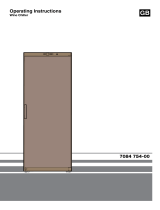
24
Safety instructions and warnings
• To prevent injury or damage to the unit, the appliance should be unpacked and set
up by two people.
• In the event that the appliance is damaged on delivery, contact the supplier imme-
diately before connecting to the mains.
• To guarantee safe operation, ensure that the appliance is set up and connected as
described in these operating instructions.
• Disconnect the appliance from the mains if any fault occurs. Pull out the plug,
switch off or remove the fuse.
• When disconnecting the appliance, pull on the plug, not on the cable.
• Any repairs and work on the appliance should only be carried out by the customer
service department, as unauthorised work could prove highly dangerous for the
user. The same applies to changing the mains power cable.
• Do not stand on the plinth, drawers or doors or use them to support anything else.
• This appliance is not intended for use by persons (including children) with reduced
physical, sensory or mental capabilities or lack of experience and knowledge unless
they have been given initial supervision or instruction concerning use of the appli-
ance by a person responsible for their safety. Children should be supervised to ensure
that they do not play with the appliance.
• Avoid prolonged skin contact with cold surfaces or chilled/frozen food. This could
cause pain, numbness and frostbite. In the case of prolonged skin contact, protective
measures should be taken, e.g. gloves should be worn.
• If you have a lockable appliance, do not keep the key near the appliance or within
reach of children.
• Do not use electrical appliances inside the appliance.
• Do not damage the refrigerant circuit pipes.
• Do not allow naked flames or ignition sources to enter the appliance. When trans-
porting and cleaning the appliance ensure that the refrigerant circuit is not dam-
aged. In the event of damage, make sure that there are no ignition sources nearby
and keep the room well ventilated.
Shutting your appliance down
If your appliance is to be shut down for any length of time, switch it off and disconnect
the plug or remove the fuse. Clean the appliance and leave the door open in order to
prevent unpleasant smells.















